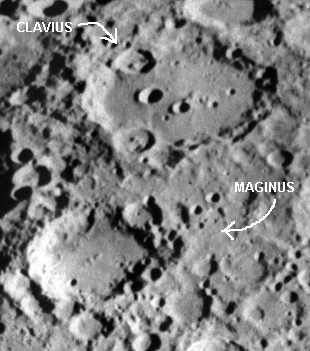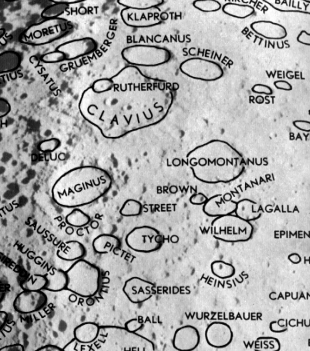

Time and Date: 2001/5/1 02:45 to 03:40 UT Location: ~10 km east of Harrisburg, PA, USA Conditions: Clear, good seeing, moderate light pollution Telescope: 114mm f/7.9 C4.5 Celstron Newtonian Oculars: 12.5mm Edscorp ortho (72x), 8mm Tele Vue Radian (112x), 2x Celestron Ultima Barlow lens (144x, 224x) Late Monday night I set up one of my small telescopes to have a quick look at the moon. While scanning along the terminator at 112x I chanced upon what I believe is a new lunar sunrise ray in the 163km walled plain Maginus (Rukl chart 73). When I first saw it the ray extended westward from the crater's eastern wall into the darkened crater floor illuminating the central peak. As time went by the ray broadened and brought more of the crater floor into view. Barlowing the 12.5mm ortho (144x) allowed me to witness the event in fine fashion. I took a number of eyepiece projection photographs using 17 and 26mm Tele Vue Ploessls. Hopefully I was able to capture the Maginus Lunar Sunrise Ray on film. Dave Mitsky
Using Harry Jamieson's "Lunar Observer's Toolkit", the empheris for the date and time in question, shows the following:
Ephemeris For 2001/ 5/ 1 at 3:15 U.T.
Site Longitude: 75.883 J.D. 2452030.63542
Site Latitude: 40.150 Sun's Alt. -29.56° (Dark)
Site Elevation: 173 meters Moon's Alt. 40.76°
Earth's Selen Sun's Selen Frac ------- Topocentric -------
Long Lat Colong Lat Illum Phase Distance Semi-Dia HP
° ° ° ° Angle° kms " '
-0.97 -4.06 6.57 -1.30 0.549 84.8 366,027.51 979.41 59.31
-------- Moon's --------- Perigee Date/ Apogee Date/ Anomalistic
R.A. Dec. Parallax Parallax Phase
9h 19m 19s 18° 57' 13" 2001/ 5/ 2 3:38 2001/ 4/17 6: 7 0.968
59.36' 54.21'
Moon's Age P.A. of Axis
(d) °
7.491 18.94
Location Map & Crater Description:


MAGINUS, -085, -770 [Italian Astronomer, 1555-1617]. A great mountain-walled depression, 110 miles in diameter, with more or less ruinous walls and broad inner slopes, disturbed by numerous craters, especially on the east and the north. Many projections run on to the floor, forming little bays, several being the relics of once-prominent rings. The lower reaches of the slopes are very gentle; the outer glacis is equally gentle and little elevated about the surface, especially on the south and the north-east.
The crest rises 14,000 feet above the interior on the west. Of the numerous ring plains that have broken the symmetry of Maginus, the largest is G, on the south-east, 30 miles in diameter with broad west slopes, a triangle of craters on the north-east, a crater on the south and craters and craterlets on the floor. East of G are other craters. On the north-east is a group of large craters, some with central peaks. The most southerly of these craters is N, which lies quite out on the floor, on the north edge of which is a ruined ring with fragmentary walls. On the western side of the floor are many craters; the largest, A, has a crater-row, running north-east. A little to the west of the centre of Maginus is a group of hills, the highest attaining 2,000 feet. Southwest of this is another mountain group, and farther south a large ruined ring lies against the inner slope. Another low ring is B, near the west wall, with hills on its interior; others are found on the east. With powerful telescopes the floor of Maginus us seen to be sprinkled over with numerous craterpits, hillocks, swellings and craterlets.From the book The Moon, by Moore and Wilkins (Faber & Faber, 1955):